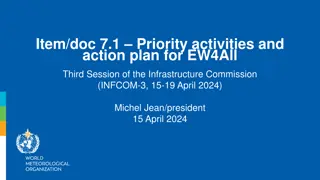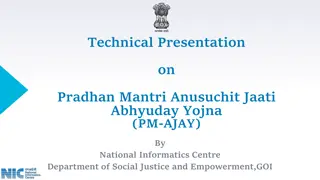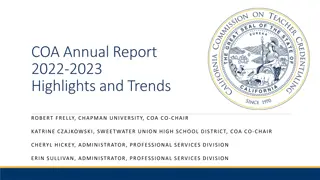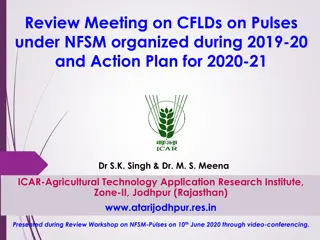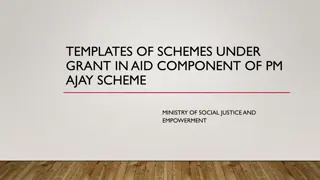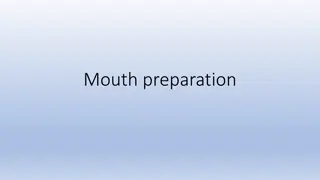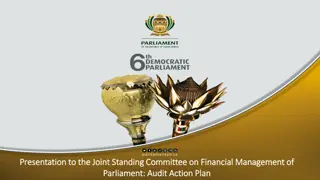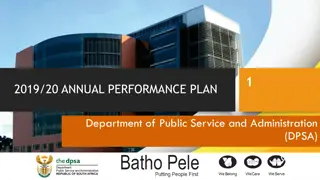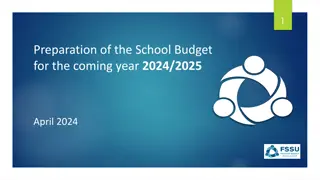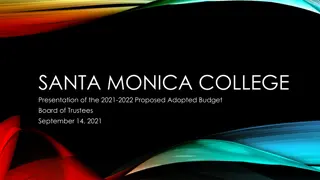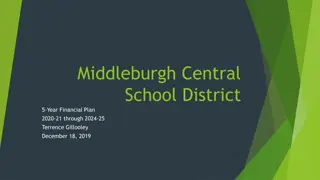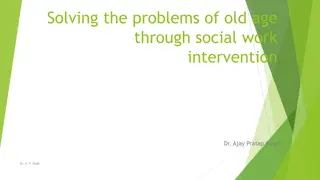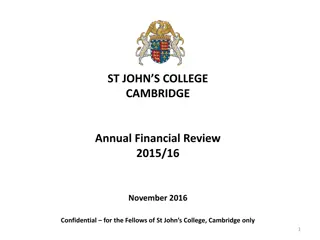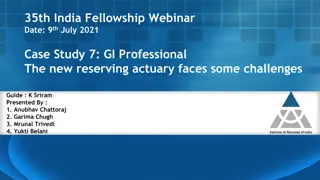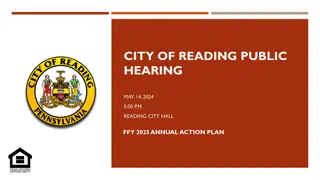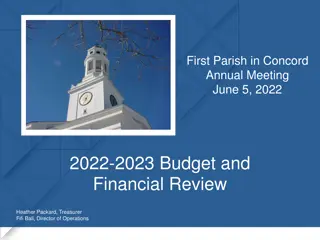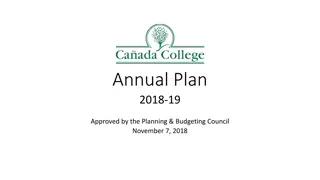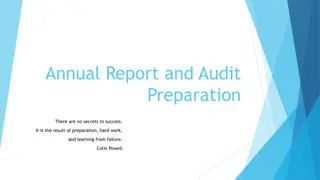Preparation of Annual Action Plan under PM-AJAY for Financial Year 2021-22
The preparation of the Annual Action Plan (AAP) under the 'Grant to States' component of Pradhan Mantri Anusuchit Jati Abhyuday Yojana (PM-AJAY) for the financial year 2021-22 involves merging three centrally sponsored schemes to achieve holistic development based on identified needs. The proposed scheme aims to reduce poverty, improve socio-economic indicators, and enhance educational opportunities for Scheduled Caste communities. Changes in the PMAGY component are suggested to streamline fund allocation and project implementation.
Download Presentation

Please find below an Image/Link to download the presentation.
The content on the website is provided AS IS for your information and personal use only. It may not be sold, licensed, or shared on other websites without obtaining consent from the author.If you encounter any issues during the download, it is possible that the publisher has removed the file from their server.
You are allowed to download the files provided on this website for personal or commercial use, subject to the condition that they are used lawfully. All files are the property of their respective owners.
The content on the website is provided AS IS for your information and personal use only. It may not be sold, licensed, or shared on other websites without obtaining consent from the author.
E N D
Presentation Transcript
Preparation of Annual Action Plan (AAP) under 'Grant to States' component of Pradhan Mantri Anusuchit Jati Abhyuday Yojana (PM-AJAY) (earlier known as Special Central Assistance to Scheduled Caste Sub Plan (SCA to SCSP) Financial Year : 2021-22 1
Some inputs about Proposed Scheme of Pradhan Mantri Anusuchit Jati Abhyuday Yojana (PM-AJAY) 2
PM-Anusuchit Jati Abhyuday Yojana (PM-AJAY) - Proposal under consideration: Merger of 3 Centrally Sponsored schemes as component schemes: Special Central Assistance to Scheduled Castes Sub Plan (SCA to SCSP) Pradhan Mantri Adarsh Gram Yojana (PMAGY) Babu Jagjivan Ram Chhatrawas Yojana (BJRCY) Rationale for merger: Holistic development based on needs identified Expansion of IT framework already in place for PMAGY Schemes have common objectives & implementing agencies More target-oriented projects suited to local requirements Better targeting of the beneficiaries Convergence of Need Assessment and coverage data Optimal utilization of resources Comprehensive monitoring mechanism Faster processing and releases 3
PM-Anusuchit Jati Abhyuday Yojana (PM-AJAY) Objectives of the proposed Scheme: Reduce poverty of the SC communities by generation of additional employment opportunities through skill development, income generating schemes and other initiatives. To improve socio-economic developmental indicators by ensuring adequate infrastructure and requisite services in the SC dominated villages. To increase literacy and encourage enrolment of SCs in schools and higher educational institutions by providing adequate residential facilities in quality institutions, as well as residential schools where required; in the aspirational districts/SC majority blocks and elsewhere in India. 4
PM-AJAY Proposed changes PMAGY Component Existing Provisions Proposed provisions Rationale Selection Criteria for villages: Scheduled villages having total population > 500 To be defined by Ministry from time to time depending on pace of coverage & availability of funds. To enable coverage of Villages more SC Population. Castes majority with Flow of Funds: The first instalment, up to 50% of the admissible grant, will be released immediately on selection of the villages Only Expenses i.e. Rs.0.80 lakh/Rs.0.40 lakh per village to be released as first instalment on selection of villages Administrative and Other To reduce parking of funds State/UT level Ensure completion No cost overrun at timely Balance admissible Central Assistance would be released in respect of the VDPs finalized Gram Sabha as 2nd instalment. Entire admissible Central Assistance of Rs.20.00 lakh/Rs.9.50 village under Gap-filling component would be released where VDPs finalized lakh per by the for villages 5
PM-AJAY Proposed changes SCA to SCSP Component Existing Provisions Proposed provisions Rationale Fund Allocation Criteria Funds are allocated to the States/UTs based on following criteria: 1. SC population of the State/UTs(40%) 2. Relative backwardness of the State/UTs (inverse of State per Capita Domestic Product)(10%) 3. % of SC families in the State/UTs covered by Composite Economic Development Programmes in the Plans to enable them to cross the Poverty line(25%) 4. Special Component Plan to the Annual Plan as compared to the SC population percentage in the State/UTs (25%) Funds State/UTs following criteria: 1. Scheduled population State/UTs(50%) 2. Proportion Component Plan to the State s Annual Plan as compared population percentage in the State/UTs (50%) allocated on to of To simplify the process incentivize States focusing more on SC welfare. basis and Castes the of of Special to the SC 6
PM-AJAY Proposed changes SCA to SCSP Component Contd.. Existing Provisions Scheduled Castes persons living below the poverty line Proposed provisions Projects creating infrastructure aimed at multiple beneficiaries for many-fold increase in income No income limits but priority to HH with income < Rs. 2.5 lakh/ year Rationale As no uniform definition BPL & for wider coverage. Evaluation report recommended. For systems or for also Individual based funding Household income below Rs. 2.5 lakhs per annum No specific provision for separate projects to be District/State level. Projects designed at District and State-level keeping in view the local needs Selection relevant projects with ownership of implementing agencies. Evaluation report recommended. of designed at Preference to district level projects. Each State/UT follows its their own systems for planning which is based mostly on a top-down approach. State-wide projects aimed at direct benefit of SCs shall also be taken up. also 7
PM-AJAY Proposed changes SCA to SCSP Component Contd.. Existing Provisions Proposed provisions Rationale Not available Proposal of Land purchase with costing on pilot basis. SECC data shows only 0.24 per cent of SC households own 2.5 acre or above area as agricultural land. Evaluation Report recommends. Recommended by last EFC. Subsidy of 50 per cent of the project cost, subject to maximum of Rs 10,000/-. Subsidy of 50 per cent of the individual asset, subject to maximum of Rs 50,000/-. For more attractive and viable projects Evaluation Report recommends. Recommended by last EFC. Funds are released to the State Government. Fund flow mechanism to Districts/States to be as per guidelines being finalized for CSS by the Ministry of Finance. Until the same is finalized, funds will be released directly to the Implementing Agencies identified by the States. Release to Implementing Agencies other than States will be done directly by Ministry using PFMS and following EAT. Individual centric benefits, if any, will be transferred in DBT mode by the implementing agencies. Eliminating parking of funds at the State level and transparency. improving 8
PM-AJAY Proposed changes BJRCY Component Existing Provisions Proposed provisions Additional focus on NIRF ranked Universities/ Institutions Rationale Expansion coverage to more SC students quality institutions. Wider and completion The scheme is implemented through the State Governments, UT Administrations and Central Universities/Institutions. of & State in The scheme presently has the following funding pattern: For Girls Hostel:100% For Boys Hostel: 50%, 90%, 100% and 45%to State Government, Universities /Institutions, Administrations and State Universities/ Institutions respectively. It is proposed to have a uniform funding pattern of 100% irrespective of gender & implementing agency coverage timely Central UT 9
PM-AJAY Proposed changes Other changes Existing Provisions Proposed provisions Rationale Provision of 5% of the total allocation under PMAGY administrative cost and 4% under SCA to SCSP 5% allocation scheme of PM-AJAY of the total the Evaluation mechanisms at all levels & emphasised on need of robust centralised IT implementation and monitoring. Funds will be used for: Setting up Technical Support Group-cum-Project Management Unit at Implementation Units at State & District levels. IT system development and maintenance. Need Assessment, including HH Surveys Trainings &Capacity Building IEC Activities Organizing events for India@75 brought out lack of monitoring of as system for planning, Centre & Project 10
PM-AJAY Proposed changes Other changes Contd.. Existing Provisions No provisions for Social Audit Proposed provisions Rationale Social Audit will be conducted once every year Better implementation and transparency For distribution of Funds There distinct schemes that are proposed to be merged each having different methodology are three The first charge on funds would be of selected PMAGY villages. Up to 2% of the total allocation will be used for Hostels proposed by other than States. Balance funds provisionally allocated amongst States based on the pre-defined criteria for District/State level projects. proper funding 11
PM-AJAY Component wise (Scheme-wise) Expenditure Name of Scheme Actual Expenditure (in Rs. Cr.) 2017-18 2018-19 2019-20 Total Special Central Assistance to Scheduled Caste Sub Plan (SCA to SCSP) 731.85 897.25 1114.73 2743.83 Pradhan Mantri Adarsh Gram Yojana (PMAGY) 39.00 167.88 717.95 924.83 Babu Jagjivan Ram Chhatrawas Yojana (BJRCY) 74.91 36.55 25.00 136.46 Total 845.76 1101.68 1857.68 3805.12 12
Background of the existing Scheme SCA to SCSP Central Sector Scheme since 1980 100 % grant under the Scheme Grant is additive to State/UT SCSP Increasing income for SCs living below the poverty line by way of Income Generating schemes, Infrastructure & Skill Development Scheme implemented in 28 States/UTs Not Covered States/UTs: States: Arunachal Pradesh, Nagaland, Meghalaya & Mizoram UTs: A & N Islands, Dadra Nagar Haveli, Daman & Diu & Lakshadweep 14
Objectives of the Scheme The main objective of the scheme is to increase the income of the target population by way of various income generating schemes, skill development activities and infrastructure development. To reduce the poverty among the target population and bring them above the poverty lines. 15
COMPONENTS Income Generating Schemes Boost Entrepreneurship among SCs Subsidy of Rs 10000/- per beneficiary or 50% of loan Skill Development Programmes Enhance Capacity Building through training Skill Training in line with National Framework Infrastructure Development Development Programmes in SC majority villages Fills critical gaps in overall development 16
ELIGIBILITY CRITERIA Income Generating Schemes and Skill Development Programmes Infrastructure Development Scheduled Castes persons living below the poverty lines Villages having 50% or more SC population
FUND ALLOCATION CRITERIA Sl. Criteria Percentage Share a) SC Population of the States/UTs 40 % b) Relative Backwardness of States/UTs 10% SC Families Covered by Composite Economic Development in the State Plan c) 25% Share of SCSP in Annual Plan as compared to SC population d) 25% 18
PROJECTS FOR INCOME GENERATION SC Families living below Poverty Line Viable Income Generating Activities Through State level implementing agencies Admissible Subsidy: Rs. 10,000/- per beneficiary (50 % of the project cost or maximum of Rs. 10,000/- per beneficiary whichever is lesser) Income generating activities designed as per the local requirements can be funded for the economic development of Scheduled Castes 19
PROJECTS FOR SKILL DEVELOPMENT SC Families living below Poverty Line At least 10% of the releases can be used for the component Skill Development activities as per Guidelines and Norms of Ministry of Skill Development & Entrepreneurship (MSDE) Placement of trained candidates either in wage employment or in self- employment must be at least 70%. The compensation of training cost should be limited to the extent of Common Cost Norms (CCN) or NCVT Guidelines as applicable from time to time. 20
4 TYPES OF SKILL DEVELOPMENT PROJECTS Up-skilling/Recognition of Prior Learning (RPL): The duration of the training programmes will be 32 to 80 hours and spaced over up to one month, duly keeping in mind the occupational hours of the trainees. Short Term Courses (focus on women and self-employment): The duration of the training programmes will be normally 200 hours to 600 hours and up-to 5 months or as stipulated in National Occupational Standards (NOS) and Qualification Packs (QPs). Entrepreneurial Development Programmes (EDP): The duration of the training will normally be 80 hours (10 days) or as stipulated in MoRD Guidelines. Long Term Courses (for global class skills for those educated up to 10th class or more): The duration of the training programmes will be six months and above and usually up to 1 year, as stipulated by the concerned Board/Regulatory Body of the training centre. 21
SKILL DEVELOPMENT INSTITUTIONS State Skill Development Missions (SSDMs) who are expected to have ground level knowledge of the skill aspirations and employment opportunities in their state as also access to literature on Skill Gap analysis carried out by National Skill Development Corporation (NSDC). Affiliated Training Providers (TPs) of SSDM/SSCs/TIs. Institutes in pannel of National Scheduled Castes Finance and Development Corporation (NSFDC). Other institutions having a good track record of conducting relevant skill training programmes and placing the trained candidates. Partners for Long Term Training should have experience of having successfully trained at least 1000 candidates during the last 3 years with > 70% placement of trained candidates. Only Govt. owned Institutions are allowed for conducting Long Term Training. 22
PROJECTS FOR INFRASTRUCTURE DEVELOPMENT Critical Infrastructure Gaps in SC Majority Villages and other Infrastructure Projects for the benefits of the target group Up to 30% of the releases can be used for the component Through State level implementing agencies priority should be given to atrocity prone areas and aspirational districts 23
OTHER PROVISIONS Up to 3 % of the total SCA released can be utilized by the States/UTs for supervision, monitoring and evaluation of the Scheme Implementation. Up to 15% of total SCA will be used for women beneficiaries. Up to 5% of total SCA will be used for specially abled beneficiaries. 2% of the total budget allocation e North Eastern States Scheme has a Committee for evaluation of Annual Action Plans submitted by the States. 24
IMPLEMENTATION, MONITORING & EVALUATION The State Governments/ Union Territory Administrations will mandatorily select the beneficiaries under the Income Generating and Skill Development projects funded under the scheme through open transparent process. The implementing agencies are expected to: maitain greater transparency and ensure time-bound processing of their applications and grounding of the scheme. The States/UTs should send the monthly physical and financial progress report on utilization of SCA within 15 days after the end of each month and the annual progress report on the utilization of funds within 1 months of the end of each financial year to the Government of India, Ministry of Social Justice and Empowerment. The financial and physical formats designed for Monthly and Annual Reports are enclosed at Format-II and III respectively. Annual Action Plan shall be prepared in decentralized manner and submitted online through web-portal: https://pmajay.dosje.gov.in. 25
Plan for 2021-22 under 'Grant to States' component of Pradhan Mantri Anusuchit Jati Abhyuday Yojana (PM- AJAY) (earlier known as Special Central Assistance to Scheduled Caste Sub Plan (SCA to SCSP) 26
PM-AJAY Plan for 2021-22 Scheme of PM-AJAY is yet to get approved from competent authority. It has been decided to run each component of the scheme as per present Scheme Guidelines of the respective Schemes. During 2021-22 the component related to earlier scheme of SCA to SCSP (Special Central Assistance for Scheduled Caste Sub Plan) will be implemented as per existing guidelines of SCA to SCSP. State needs to submit their Annual Action Plan (AAP) in online mode through the web-portal https://pmajay.dosje.gov.in. Login credentials for State and District Level Officers has been sent to email of Principal Secretary of the States. There are two id's for each level (State/District). One for creation of projects and another for its approval. De-centralised planning will be used for creation of projects.
PM-AJAY Component wise proposed outlay Sl. Name of component Outlay proposed (in Rs.cr.) 2021-22 2022-23 2023-24 2024-25 2025-26 Total 1. Adarsh Grams (appx. 50%) 900 975 1025 1075 1125 5100 2. Administration, Monitoring and Evaluation ( up to 5%) 90 97.5 102.5 107.5 112.5 510 3. Construction/expansion/maint enance of Hostels not covered by the States (up to 2%) Grant in Aid to the District/State Total 36 39 41 43 45 204 4. 774 838.5 881.5 924.5 967.5 4386 1800 1950 2050 2150 2250 10200 28
PM-AJAY Notional allocation of funds under Grants to States Sl. No. 1 2 3 4 5 6 7 8 9 10 11 12 13 14 State Notional Allocation Sl. No. 15 16 17 18 19 20 21 22 23 24 25 26 27 28 State Notional Allocation Andhra Pradesh Assam Bihar Chandigarh Chhattisgarh Delhi Goa Gujarat Haryana Himachal Pradesh Jammu & Kashmir Jharkhand Karnataka Kerala 2979.15 4476.68 5626.68 77.40 1067.74 294.22 5.26 1291.43 1774.33 687.82 323.68 1203.99 3753.16 952.20 Madhya Pradesh Maharashtra Manipur Odisha Puducherry Punjab Rajasthan Sikkim Tamil Nadu Telangana Tripura Uttar Pradesh Uttarakhand West Bengal 4865.33 4680.20 463.55 2477.31 15.58 3278.51 4215.26 58.01 5367.78 1914.50 2742.75 14742.49 556.07 7508.61 TOTAL (Rs. 773.9970 Lakh) 29
ANNUAL ACTION PLAN (AAP) It would be mandatory for the State Governments/UTs Administrations to submit the Annual Action Plan in order to get the grants under the scheme. The Annual Action Plan should be submitted by the end of May of every year so that the appraisal process is completed by end of June and the second installment is released thereafter. State Governments/UTs Administration may prepare the AAP as per the local requirements indicating the various income generating schemes, skill development programmes, infrastructure development requirements in convergence with State SCSP etc. The format for submitting the Annual Action Plan is enclosed at Format-I (A to F) of Scheme Guidelines but AAP is required to be submitted online. 30
ILLUSTRATIVE LIST OF PROJECTS 1. AGRICULTURE & SOIL CONSERVATION a) Training-cum-demonstration to Scheduled Castes farmers. b) Distribution of seeds/fertilizers/pesticides etc. to Scheduled Castes farmers. c) High yielding variety programme in Scheduled Caste cultivators land. d) e) f) Commercial crops programme in Scheduled Caste cultivators land. Assistance for promoting organic and environment friendly farming. Assistance to persons/landless reclamation/development of their lands. Assistance to Scheduled Caste families who have been distributed surplus land for developing and cultivating the land. Honey Bee keeping and processing. Sericulture and related activities. Plantation of specific species as part of soil conservation measures. agricultural labourers belonging to Scheduled Castes for g) h) i) j) k) Other measures for soil conservation. 31
ILLUSTRATIVE LIST OF PROJECTS 2. HORTICULTURE a) Training to Scheduled Castes farmers in growing, marketing of fruits and vegetables produce. b) Taking up fruit and vegetable plantation in Scheduled Castes beneficiary land. c) Small nurseries, seed farms etc. incidental to the above. 3. MINOR IRRIGATION a) Subsidy/assistance to individual beneficiaries for dug-wells, tube wells, irrigation pump sets, farm ponds etc. b) Check-dams, diversion channels, water harvesting structures, dug-wells, tube- wells, cooperative lift points for Scheduled Caste groups/communities having 50% or more Scheduled Caste beneficiaries. 32
ILLUSTRATIVE LIST OF PROJECTS 4. ANIMAL HUSBANDARY a) Training of Scheduled Castes for promotion of Animal Husbandry. b) Assistance for milch cattle and diary farming. c) Assistance for poultry. d) Assistance for goat/sheep. e) Assistance for pigs and duck units. f) Assistance to Animal Husbandry related cooperative societies in the areas with substantial Scheduled Caste population. 33
ILLUSTRATIVE LIST OF PROJECTS 5. FISHERIES a) Training of Scheduled Castes in fish production, collection etc. b) Assistance to Scheduled Caste families for pisciculture. c) Subsidy/assistance to Scheduled Caste fishermen to purchase fishing boats, nets etc. d) Development of Scheduled Caste fishermen cooperatives. 6. FOOD PROCESSING a) Support for food processing activities. 7. FORESTRY, ECOLOGY AND ENVIRONMENT a) Development of Social and agro-forestry benefiting Scheduled Caste families. b) Programmes for improvement of ecology and environment having a bearing on family-oriented economic programmes. 34
ILLUSTRATIVE LIST OF PROJECTS 8. HANDICRAFTS AND HANDLOOMS a) Assistance to Scheduled Caste artisans/craftsmen for setting up of businesses and small and cottage industries. b) Introduction of new craft programmes among Scheduled Caste families. c) Assistance for promotion of Handloom and Textiles. 35
ILLUSTRATIVE LIST OF PROJECTS 9. INDUSTRY, SERVICE AND BUSINESS (ISB) Manufacturing units Readymade garments units Leather units Retail shops, Grocerys and Showrooms Carpentry, Furniture making units Printing units Electronics related activities Brick making units Bakery units Rubber units Boutiques Plumbing Auto, Automobile repair units Gems &Jewellery related activities IT/ITeS Services Media and Entertainment Healthcare Banking & Financial Services related. Others Paints and coating units Beauty parlour 36
ILLUSTRATIVE LIST OF PROJECTS 10. HANDICRAFTS AND HANDLOOMS a) Formation of new cooperatives and strengthening existing Cooperatives with substantial Scheduled Caste members for promoting ventures in various sectors. b) Working capital assistance to Scheduled Caste cooperatives engaged in production of consumable items etc. c) Strengthening of consumer cooperatives, labour cooperatives and other cooperatives having a substantial number of Scheduled Caste members. d) Training to Scheduled Caste members of cooperatives in management and administration of cooperatives. e) Processing/marketing cooperatives. 37
Plan for 2021-22 Release of funds during 2021-22 38
RELEASE OF FUNDS (present procedure) While releasing the first instalment (50% of Notional Allocation), the Utilization Certificate of the grants released for the previous to last year Financial Year would be necessary. The second instalment to the State Government/UTs Administration would be released subject to the following conditions: The State Government/UT Administration should furnish the information on effort based criteria i.e percentage of families covered by Composite Economic Development Programmes & Special Component Plan to the Annual Plan as compared to the SC population latest by the month of August every year. Utilization of at least 50% of the SCA released to them in the previous financial year should be submitted by the State Governments/UTs Administrations. The State Governments/UTs Administrations should have submitted their Annual Action Plan (AAP) including details of Allocation and Utilization of DAPSC/AWSC/SCSP funds. The Project Appraisal Committee (PAC) set up under the scheme should have appraised and approved the activities based on the Annual Action Plan and reviewed the implementation of AWSC/SCSP. 39
RELEASE OF FUNDS (revised procedure) State/UT Government will designate a Single Nodal Agency(SNA), who will open Single Nodal Account at State level in a Scheduled Commercial Bank. The Implementing Agencies(IAs) should use the SNA s account or may open Zero-Balanced Subsidiary Accounts (ZBSA). All ZBSA will have allocated drawing limits to be decided by SNA from time to time. The SNA account and all ZBSA should preferably by maintained with the same bank. The State Scheme Manager (SSM) will register/configure an SNA for an State Level Scheme (SLS). The States will maintain separate budget lines for Central and State share in respect of CSS in their Detailed Demand for Grants (DDG), and make necessary provisions of State Share in the State s budget. 40
RELEASE OF FUNDS (revised procedure) The State Government will register the SNA and all IAs on PFMS and use the unique PFMS ID assigned to the SNA and IAs for all payments to them. Bank accounts of the SNAs, IAs, vendors and other organisations receiving funds will also be mapped in PFMS. SNA and IAs will mandatorily use the EAT module of PFMS or integrate their systems with the PFMS to ensure that information on PFMS is updated by each IA at least once every day. Existing bank accounts of IAs should be closed & funds lying in these account must be transferred to SNA. 41
RELEASE OF FUNDS (revised procedure) One Central Government Scheme can be linked to multiple SLS. If the SNA opts for having ZBSA for the IAs, new ZBSAs should be opened. If scheme implemented using PD Accounts or accounts of similar style, then also balances need to be transferred to SNA account. The Ministry/Department will release the Central Share to the State Government s Account held in the Reserve Bank of India for further release to the SNA s account. The State Government will transfer the Central Share received in its account in the RBI to the concerned SNA s account within a period of 21 days of its receipt. Only 25% of the allocated fund will be transfeted during each quarter subject to assessment of balance available in the SNA account. 42
RELEASE OF FUNDS (revised procedure) Mapping of Agencies: 1. SSM need to approach, State Directorate of PFMS stationed in the State Hqrs., with all relevant details such as SLS codes, Bank Account numbers of SNA and ZBSAs, hierarchy of implementation of the SLS etc. for configuring the same in the PFMS portal. 2. The SNA and all IAs need to be registered on PFMS for the respective SLS. It will be the responsibility of the SSM to register and map the first level agency i.e. SNA in the hierarchy, for the Scheme (s) administered by him. 3. Further registration of IAs and mapping the IAs in the hierarchy can be carried out by the upper level agencies. 43
RELEASE OF FUNDS (revised procedure) Mapping of Schemes: 1. State treasury system (IFMS of State) should have the information of SLS, unique code, bank accounts of SNA. These details will be shared by PFMS with State treasuries through web service or any other mode. 2. On release of funds to SNAs by the State treasury system, the payment and other details as per point 1 above should be shared with PFMS through the Treasury Integration route. 3. The Finance Department in the State shall ensure that the SLS and corresponding heads of accounts (both Centre and State share) are mapped correctly in the PFMS-State Treasury interface. 4. Finance Department in the State shall ensure interchange of data with PFMS through Treasury interface module on daily basis. This will facilitate provision of accurate information to various MIS users of GoI and States to monitor the utilisation of funds. 44
THANK YOU 45




